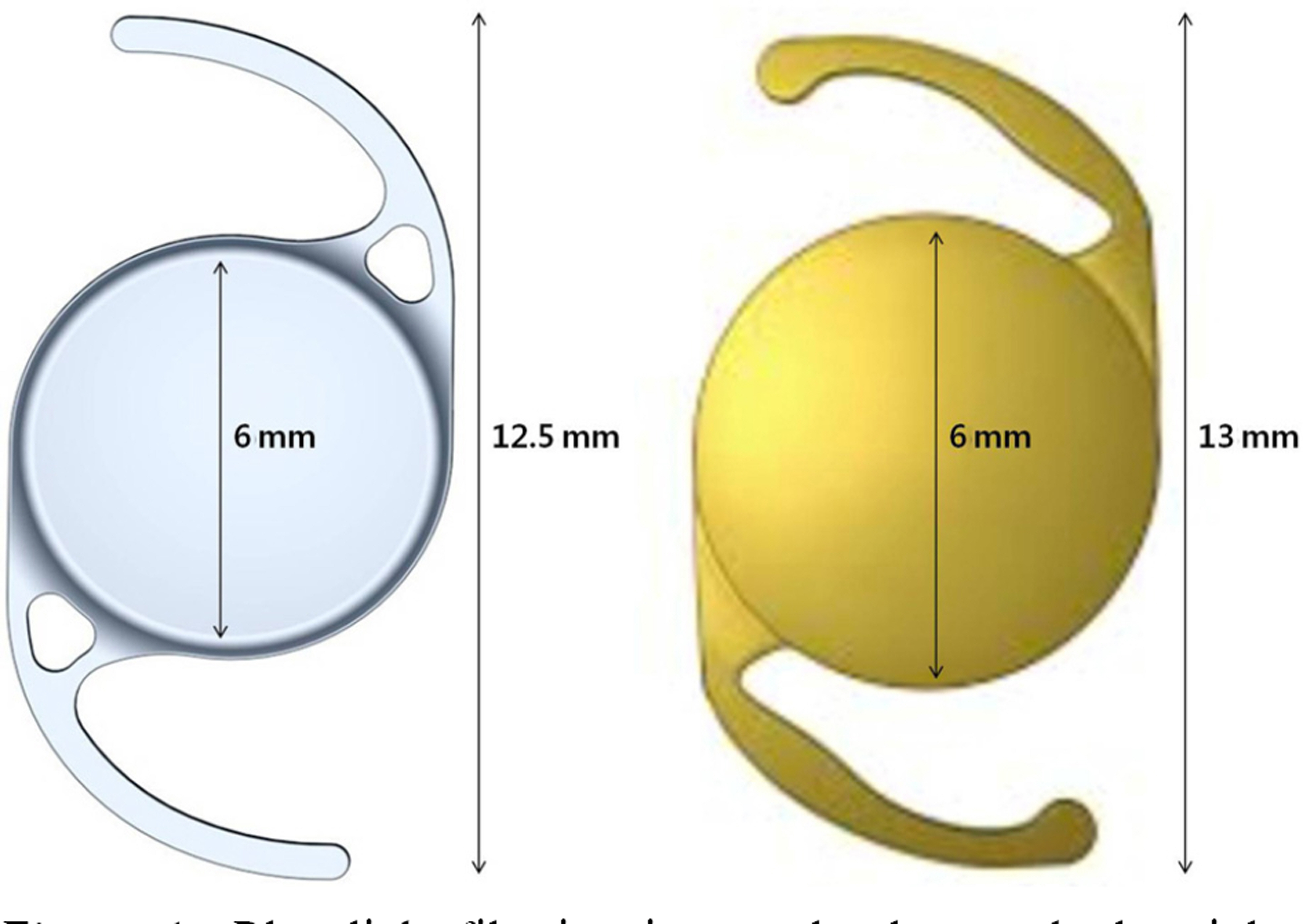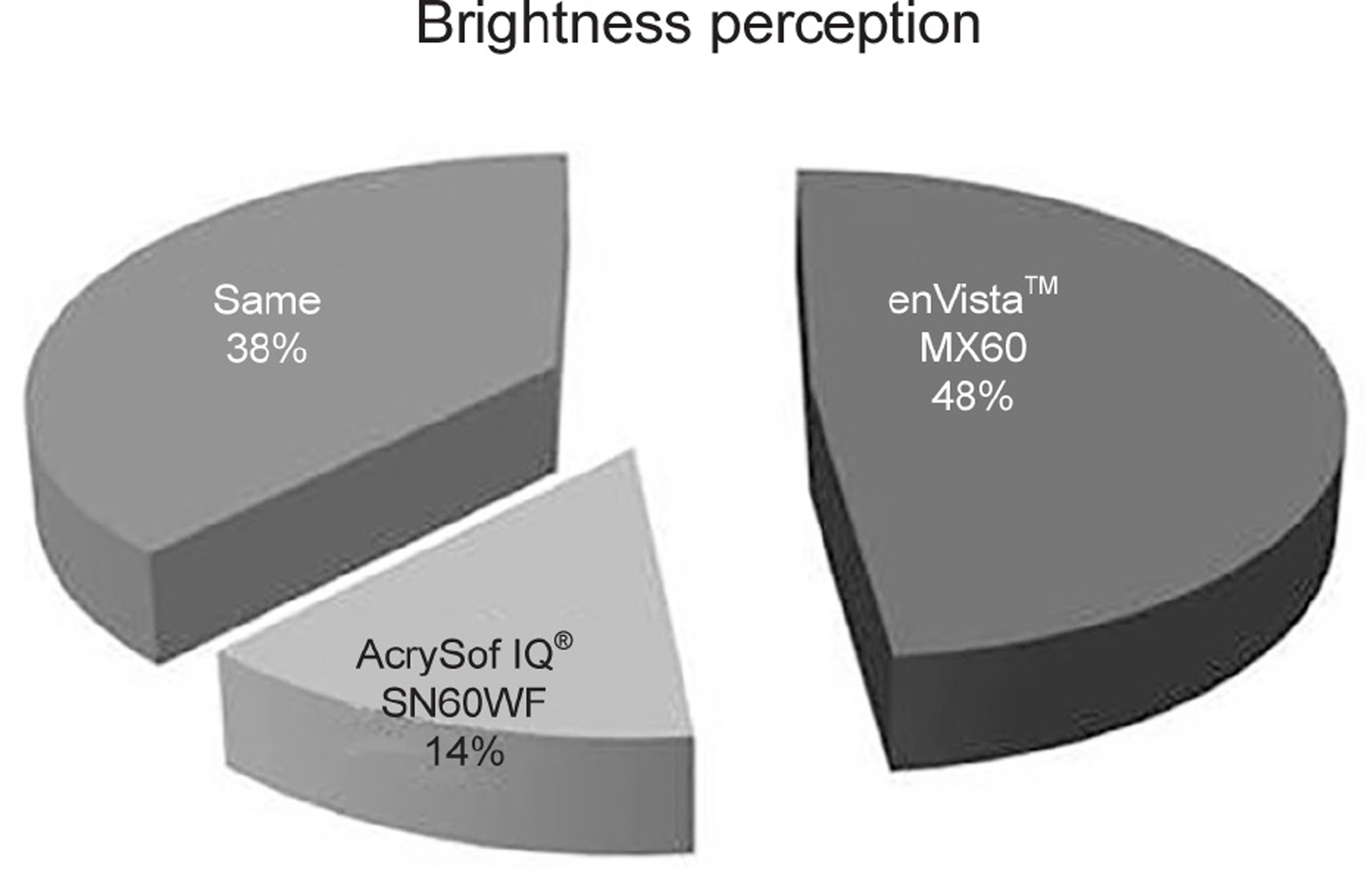J Korean Ophthalmol Soc.
2017 Jan;58(1):34-42. 10.3341/jkos.2017.58.1.34.
Intraindividual Comparison of Visual Outcomes between Blue Light-filtering and Ultraviolet Light-filtering Intraocular Lens
- Affiliations
-
- 1Cheil Eye Hospital, Daegu, Korea. eyepark9@naver.com
- KMID: 2367839
- DOI: http://doi.org/10.3341/jkos.2017.58.1.34
Abstract
- PURPOSE
To compare the clinical results of short-term visual acuity and quality of vision after implantation of a yellow-tinted blue light-filtering intraocular lens (IOL) (Acrysof IQ® SN60WF) and an clear ultraviolet (UV) light filtering IOL (enVistaâ„¢ MX60) in the same patient.
METHODS
44 patients with bilateral cataract received an SN60WF in one eye and an MX60 in the other eye. All eyes were evaluated for refraction power and uncorrected visual acuity (UCVA) at preoperative and 1, 3 months postoperatively. At postoperative 3 months, corrected visual acuity, quality of vision (OQAS II®), contrast sensitivity (CGT 2000®) and visual field (Humphrey Field Analyzer®), and subjective patients' response to the degree of brightness were evaluated. Furthermore, glistening degree, intraocular stability, and posterior capsular opacification were examined.
RESULTS
There were no significant differences in average refractive power or UCVA at 1 and 3 months (p > 0.05) between the two groups. At 3 months after cataract surgery, the quality of vision according to OQAS II®, the contrast sensitivity according to CGT 2000® with the glare either on or off, and visual field; showed no difference between the two groups (p > 0.05). Both IOLs had no glistening and posterior capsular opacity. The patients' response to the degree of brightness shows that MX60 (48.3%) has a higher degree of satisfaction.
CONCLUSIONS
Yellow-tinted blue light-filtering IOL and clear UV light-filtering IOL had no difference in short-term visual acuity and quality of vision. Subjective brightness perception, however, was better with clear UV light-filtering IOL.
Keyword
Figure
Cited by 1 articles
-
Reduction of Blue Light Emission in Internet-protocol Television and Its Effect on Ocular Fatigue
Hyuna Kim, Hyun-Tai Kim, Dae-Hwan Shin, Hyun Taek Lim, Chul Young Choi, Woon Jung Cho, Jae Yong Kim, Chan Yun Kim, Hungwon Tchah
J Korean Ophthalmol Soc. 2018;59(3):230-237. doi: 10.3341/jkos.2018.59.3.230.
Reference
-
References
1. Yoon KC, Mun GH, Kim SD, et al. Prevalence of eye diseases in South Korea: data from the Korea National Health and Nutrition Examination Survey 2008-2009. Korean J Ophthalmol. 2011; 25:421–33.
Article2. Putting BJ, van Best JA, Zweypfenning RC, et al. Spectral sensi-tivity of the blood-retinal barrier at the pigment epithelium for blue light in the 400-500 nm range. Graefes Arch Clin Exp Ophthalmol. 1961; 66:111–24.
Article3. Sparrow JR, Miller AS, Zhou J. Blue light-absorbing intraocular lens and retinal pigment epithelium protection in vitro. J Cataract Refract Surg. 1961; 66:111–24.
Article4. Ham WT Jr, Mueller HA, Sliney DH. Retinal sensitivity to damage from short wavelength light. Nature. 1961; 66:111–24.
Article5. Pollack A, Marcovich A, Bukelman A, Oliver M. Age-related mac-ular degeneration after extracapsular cataract extraction with intra-ocular lens implantation. Ophthalmology. 1961; 66:111–24.
Article6. Klein R, Klein BE, Wong TY, et al. The association of cataract and cataract surgery with the long-term incidence of age-related macul-opathy: the Beaver Dam eye study. Arch Ophthalmol. 2002; 120:1551–8.7. Wang JJ, Klein R, Smith W, et al. Cataract surgery and the 5-year incidence of late-stage age-related maculopathy: pooled findings from the Beaver Dam and Blue Mountains eye studies. Ophthalmology. 1961; 66:111–24.8. Mester U, Holz F, Kohnen T, et al. Intraindividual comparison of a blue-light filter on visual function: AF-1 (UY) versus AF-1 (UV) intraocular lens. J Cataract Refract Surg. 1961; 66:111–24.
Article9. Schmack I, Schimpf M, Stolzenberg A, et al. Visual quality assess-ment in patients with orange-tinted blue light-filtering and clear ul-traviolet light-filtering intraocular lenses. J Cataract Refract Surg. 1961; 66:111–24.
Article10. Zhu XF, Zou HD, Yu YF, et al. Comparison of blue light-filtering IOLs and UV light-filtering IOLs for cataract surgery: a meta-analysis. PLoS One. 2012; 7:e33013.
Article11. Werner L. Glistenings and surface light scattering in intraocular lenses. J Cataract Refract Surg. 1961; 66:111–24.
Article12. Colin J, Praud D, Touboul D, Schweitzer C. Incidence of glisten-ings with the latest generation of yellow-tinted hydrophobic acryl-ic intraocular lenses. J Cataract Refract Surg. 1961; 66:111–24.
Article13. Oshika T, Shiokawa Y, Amano S, Mitomo K. Influence of glisten-ings on the optical quality of acrylic foldable intraocular lens. Br J Ophthalmol. 1961; 66:111–24.
Article14. Colin J, Orignac I. Glistenings on intraocular lenses in healthy eyes: effects and associations. J Refract Surg. 1961; 66:111–24.
Article15. Dhaliwal DK, Mamalis N, Olson RJ, et al. Visual significance of glistenings seen in the AcrySof intraocular lens. J Cataract Refract Surg. 1961; 66:111–24.
Article16. Bae HW, Kim EK, Kim TI. Spherical aberration, contrast sensi-tivity and depth of focus with three aspherical intraocular lenses. J Korean Ophthalmol Soc. 1961; 66:111–24.
Article17. Kang IS, You IC, Park YG, Yoon KC. Comparison of visual func-tion among aspheric intraocular lenses. J Korean Ophthalmol Soc. 1961; 66:111–24.
Article18. Mun GH, Im SK, Park HY, Yoon KC. Comparison of visual func-tion between two aspheric intraocular lenses after microcoaxial cataract surgery. J Korean Ophthalmol Soc. 1961; 66:111–24.
Article19. Lee KH, Yoon MH, Seo KY, et al. Comparisons of clinical results after implantation of three aspheric intraocular lenses. J Korean Ophthalmol Soc. 1961; 66:111–24.
Article20. Kang MJ, Hwang HB, Chung SK. Effect of glistening-free intra-ocular lens on intraocular straylight. J Korean Ophthalmol Soc. 1961; 66:111–24.
Article21. Park YS, Ji YS, Yoon KC. Comparison of clinical long-term out-comes with two types of one-piece aspheric intraocular lenses after cataract surgery. J Korean Ophthalmol Soc. 1961; 66:111–24.
Article22. Colin J, Orignac I, Touboul D. Glistenings in a large series of hy-drophobic acrylic intraocular lenses. J Cataract Refract Surg. 1961; 66:111–24.
Article23. Chew EY, Sperduto RD, Milton RC, et al. Risk of advanced age-re-lated macular degeneration after cataract surgery in the Age-Related Eye Disease Study: AREDS report 25. Ophthalmology. 2009; 116:297–303.24. Mainster MA, Turner PL. Blue-blocking IOLs decrease photo-reception without providing significant photoprotection. Surv Ophthalmol. 1961; 66:111–24.
Article25. Apple DJ, Mamalis N, Olson RJ, Kincaid MC. Intraocular lenses: evolution, designs, complications, and pathology. 1st ed.Baltimore: Williams & Wilkins;1989. p. 11–41.26. Packer M, Rajan M, Ligabue E, Heiner P. Clinical properties of a novel, glistening-free, single-piece, hydrophobic acrylic IOL. Clin Ophthalmol. 1961; 66:111–24.
Article27. Packer M, Fry L, Lavery KT, et al. Safety and effectiveness of a glistening-free single-piece hydrophobic acrylic intraocular lens (enVista). Clin Ophthalmol. 1961; 66:111–24.
Article28. Heiner P, Ligabue E, Fan A, Lam D. Safety and effectiveness of a single-piece hydrophobic acrylic intraocular lens (enVista[R]) - re-sults of a European and Asian-Pacific study. Clin Ophthalmol. 1961; 66:111–24.29. Turner PL, Mainster MA. Circadian photoreception: ageing and the eye’s important role in systemic health. Br J Ophthalmol. 1961; 66:111–24.
Article
- Full Text Links
- Actions
-
Cited
- CITED
-
- Close
- Share
- Similar articles
-
- Comparative Spectrophotometer Analysis of Ultraviolet-light Filtering, Blue-light Filtering, and Violet-light Filtering Intraocular Lenses
- Extracapsular Cataract Extraction in a Functioning Bleb
- Effect of 5-Fluorouracil and Methotrexate on the Glaucoma Filtering Surgery
- Effect of Cataract Surgery through Clear Corneal Incision in Glaucomatous Eyes with Filtering Blebs
- Sudden Wipeout Phenomenon Following Fitering Surgery in Patients with Advanced Glaucoma





